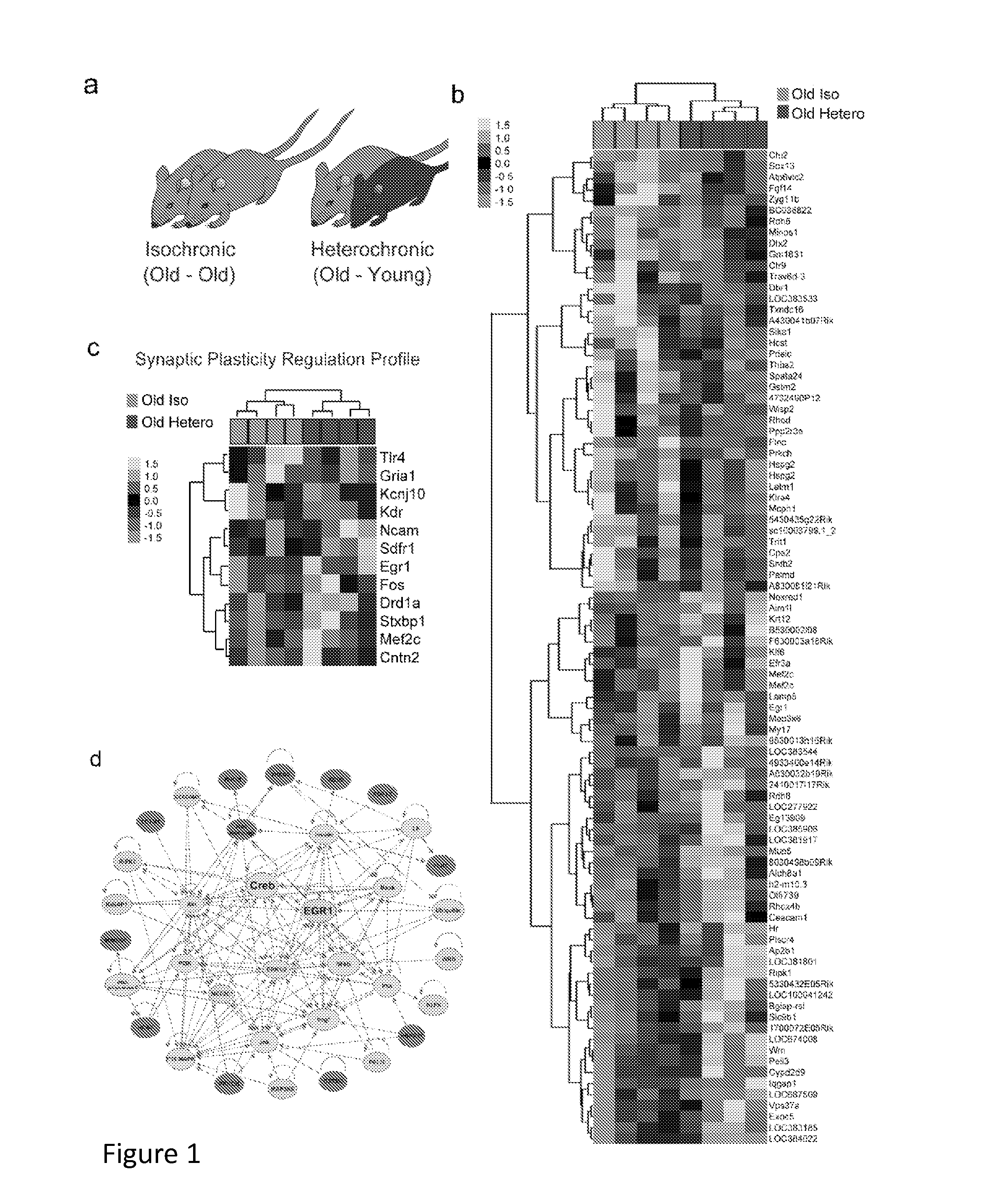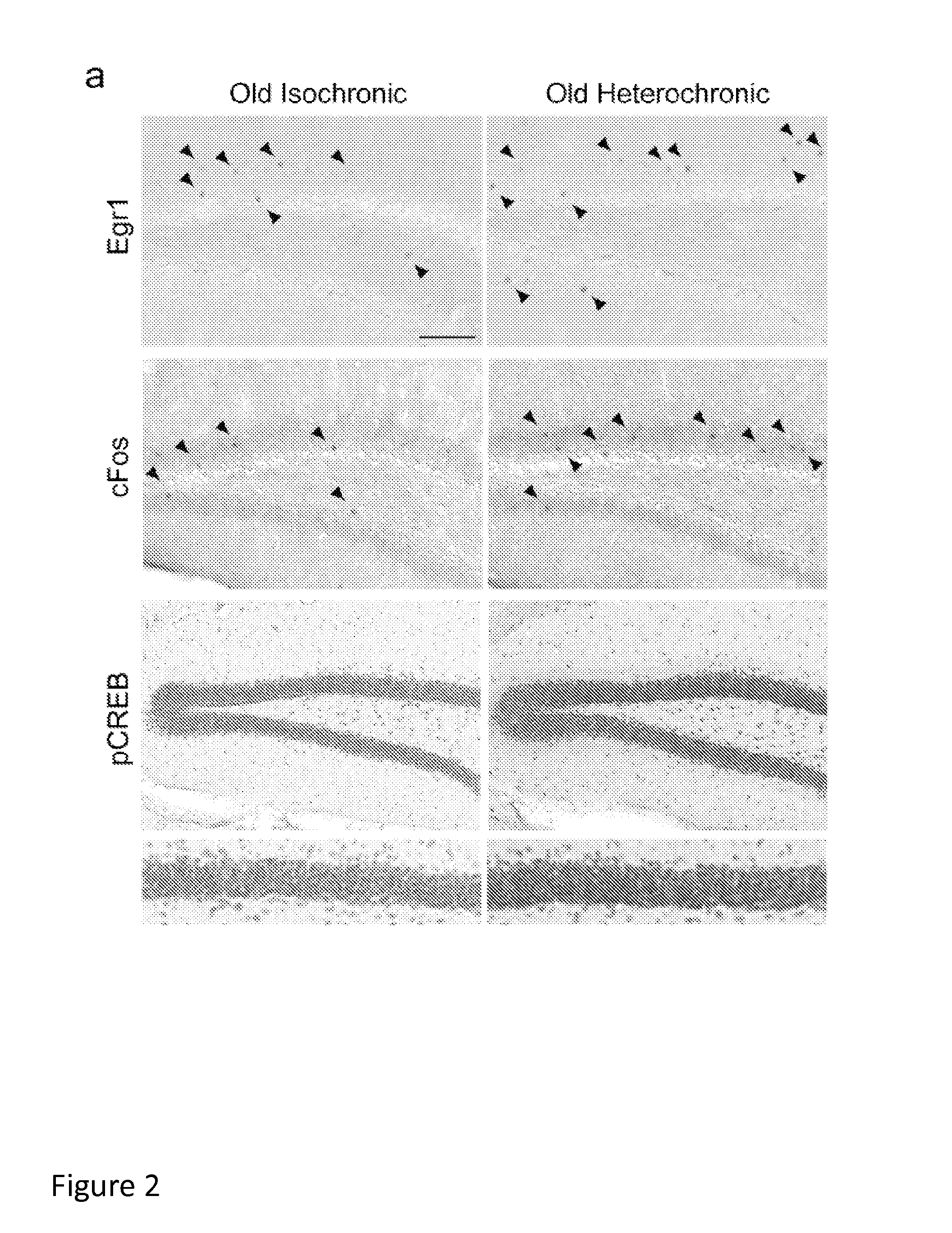Methods and compositions for treating aging-associated conditions
a technology for aging brain and composition, applied in the field of methods and compositions for treating aging brain and related conditions, can solve the problems of loss of synaptic function, loss of neuronal function, and vulnerability of aging brain neurons to sub-lethal effects
- Summary
- Abstract
- Description
- Claims
- Application Information
AI Technical Summary
Benefits of technology
Problems solved by technology
Method used
Image
Examples
example 1
[0119]It is shown here that exposure of an old animal to young blood can counteract the pre-existing effects of brain aging at a structural, functional and cognitive level. Using genome-wide microarray analysis of heterochronic parabionts—in which the circulatory systems of young and old animals are connected—an expression profile was identified indicative of enhanced plasticity in the hippocampus of old mice. Moreover, structural enhancements in the dendritic spine density of mature neurons and functional improvements in synaptic plasticity were observed in the hippocampi of old heterochronic parabionts. Lastly, intravenous administration of young blood plasma into old mice improved age-related cognitive impairments in both contextual fear conditioning and spatial learning and memory. Together, these data indicate that exposure to young blood late in life is capable of reversing age-related changes present in the old brain.
Materials and Methods
[0120]Animals. C57BL / 6 young mice (Jac...
example 2
[0145]To assess the necessity of soluble factors present in young plasma in mediating rejuvenating effects on cognition, we treated old mice (18 mos.) by tail vein injection with young plasma or heat-denatured plasma. PBS was injected as a control to assess the possibility that dilution of negative factors present in the circulation could underlie cognitive improvement. Plasma was collected from young (8 weeks) C57BI / 6J mice and pooled prior to dialysis with a 3.5 kDa molecular weight exclusion membrane. A portion of plasma was heat-denatured by 2-3 minutes of denaturation at 95° C. Mice were injected 8 times over several weeks and exposed to a fear conditioning paradigm to assess hippocampal-dependent memory. Following the first day of training in which mice were given a mild foot shock paired with a light and tone, mice were exposed to the same context and freezing behavior was assessed. The cage environment was then changed and freezing behavior was measured to assess memory that...
example 3
[0146]To optimize the delivery of young plasma, an experiment was conducted in which plasma from 2-month-old mice was administered to 18-month-old mice only once a week (150 μl / injection) for three weeks before cognitive testing and histological analysis (FIG. 8). These studies were conducted completely blinded. As illustrated in FIG. 10, we observed increased freezing in the contextual fear conditioning paradigm, better RAWM performance, and twice as many BrdU+ neurons in mice treated with young plasma compared with age-matched saline treated controls.
PUM
 Login to View More
Login to View More Abstract
Description
Claims
Application Information
 Login to View More
Login to View More - R&D
- Intellectual Property
- Life Sciences
- Materials
- Tech Scout
- Unparalleled Data Quality
- Higher Quality Content
- 60% Fewer Hallucinations
Browse by: Latest US Patents, China's latest patents, Technical Efficacy Thesaurus, Application Domain, Technology Topic, Popular Technical Reports.
© 2025 PatSnap. All rights reserved.Legal|Privacy policy|Modern Slavery Act Transparency Statement|Sitemap|About US| Contact US: help@patsnap.com



